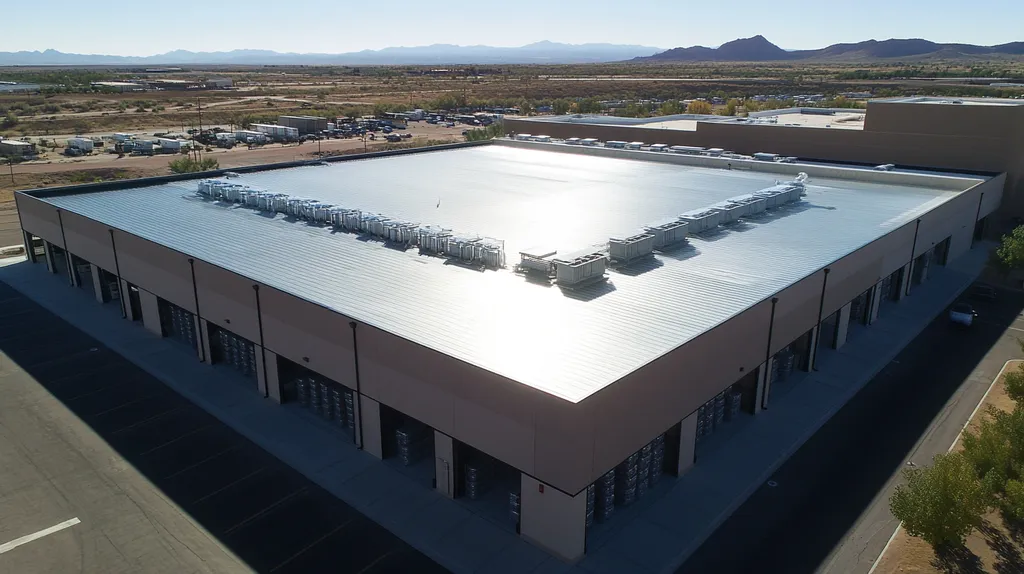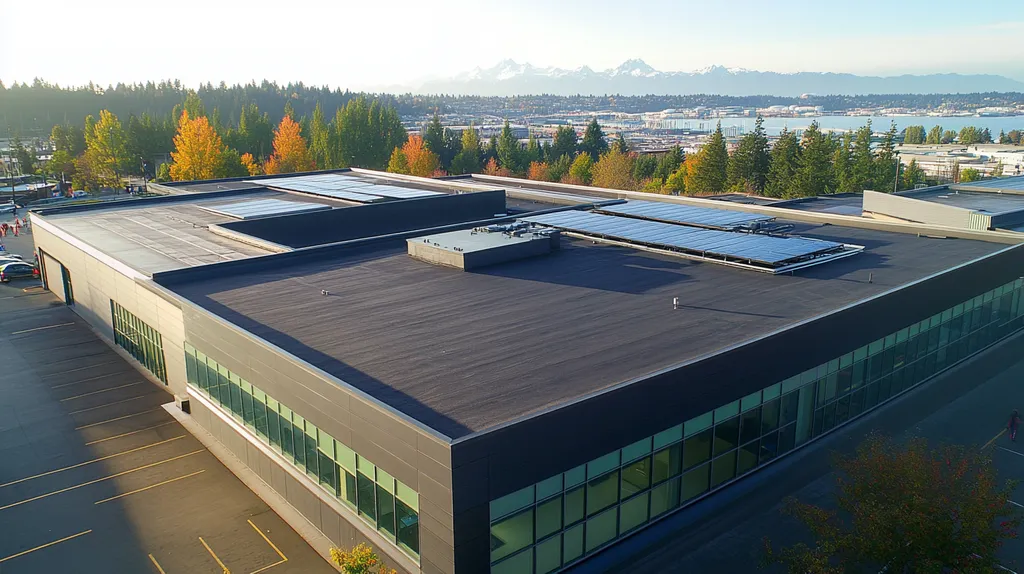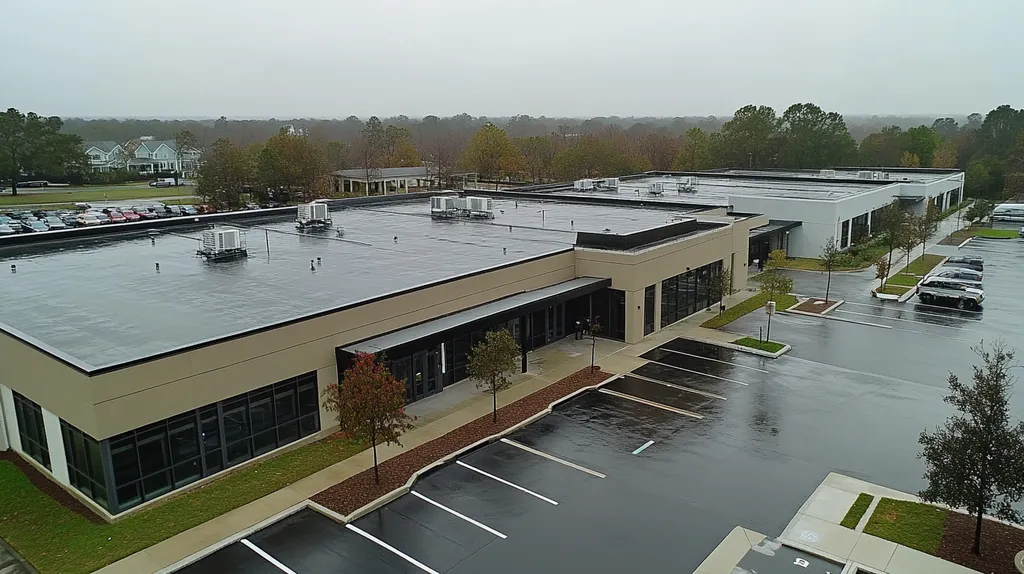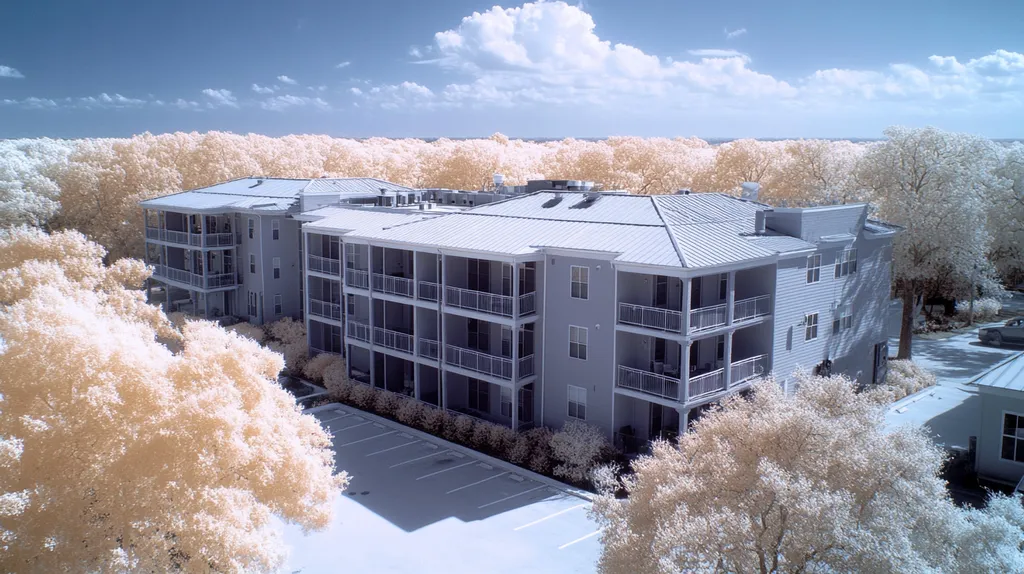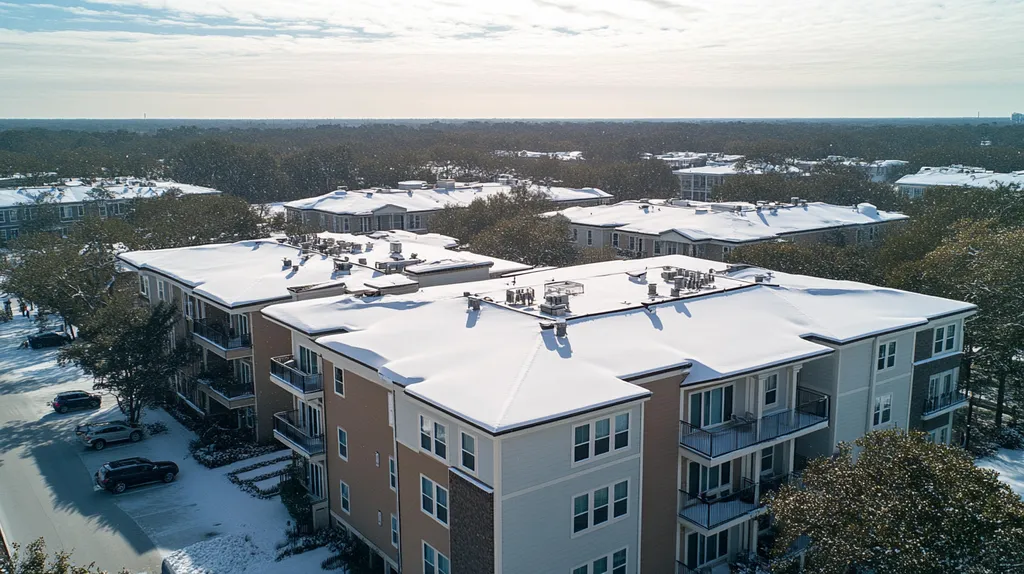Commercial building owners face a critical challenge: over 80% of premature roof failures stem from improper coating selection and application, resulting in millions in avoidable repair costs annually.
As the commercial roofing industry continues to evolve, understanding the distinctions between leading coating brands has become essential for protecting valuable real estate assets.
This comprehensive guide examines the top commercial roof coating manufacturers, analyzing their performance metrics, application requirements, and cost-effectiveness to help property managers make informed decisions about their roofing investments.
SECTION 1: THE BASICS EXPLAINED
In the realm of commercial roofing, roof coatings represent a crucial yet often underappreciated solution for building owners aiming to minimize long-term costs. Recent studies show that roofing failures can lead to financial losses that are staggering, underscoring the critical need for effective maintenance strategies. This section will clarify what roof coatings are, outline their significance for the durability of your building, and explain how they provide essential protection against harsh environmental conditions.
What It Is (In Plain Language)
Roof coatings are specialized, liquid-applied products that form a protective layer over existing roofing materials. Available in various formulations such as acrylics, silicones, and polyurethanes, these coatings can be tailored to meet the specific requirements of each roof. They create a seamless barrier that enhances both the durability and energy efficiency of the roofing system.
Think of roof coatings as sunscreen for your building’s top. They shield the roof from harmful ultraviolet rays and harsh weather conditions while providing rejuvenation to an aging roof surface. As a result, they can significantly extend a roof’s lifespan and reduce the frequency of expensive replacements.
Many property owners may not recognize the profound impact that simply applying a coating can have on overall roof performance. This protective layer can effectively block leaks and markedly improve energy efficiency, allowing for more informed decision-making that contributes to the roof’s long-term health as well as the entire building’s wellbeing.
Why It Matters (To Your Building)
The financial benefits of roof coatings cannot be overstated. A well-maintained roof can reduce energy bills by as much as 30%, owing to improvements in insulation and heat reflection. By investing in a high-quality roof coating, property owners can make their roofs more resilient to damage, ultimately lowering repair costs and prolonging service life.
Additionally, roof coatings play a vital role in sustainability. Their reflective properties help deflect solar radiation, maintaining cooler indoor environments and leading to reduced energy consumption. This not only results in savings but also supports LEED certification and other green building standards, fostering an eco-friendly reputation.
Neglecting the potential advantages of roof coatings can lead to substantial structural problems down the line. Leaks can cause extensive damage, resulting in costly repairs and diminished property values.
For mid-sized commercial buildings, adopting roof coatings can yield significant long-term savings, marking it as a pivotal decision for facility managers focused on sustaining operational efficiency.
How It Works
Roof coatings operate by adhering directly to the existing roof surface, creating a seamless barrier against moisture and UV exposure. The application process typically involves cleaning the roof, addressing any existing damages, and then applying the coating using rollers or spray equipment.
After application, the coating cures into a robust, flexible layer that can withstand temperature fluctuations without cracking. These waterproof properties effectively prevent leaks, ensuring a sound roofing system.
Many of the latest coatings contain advanced additives designed to enhance performance. For instance, reflective pigments can drastically decrease heat absorption, leading to cooler indoor temperatures during the hotter months.
By understanding the application and functionality of roof coatings, building owners can strategically enhance their roofing systems for optimal efficiency and endurance, ultimately safeguarding their investments for the long haul.
SECTION 2: PRACTICAL APPLICATIONS
Selecting the appropriate commercial roof coating is imperative for maximizing the longevity and efficiency of a building’s roof. Property owners must grasp specific applications that can significantly affect their financial outcomes. For example, studies show that roofs treated with suitable coatings can lead to energy savings of up to 30%. Understanding when and how to utilize these coatings empowers facility managers to make strategic decisions that protect their investments and prolong the life of their roofing systems.
Common Uses & Examples
Commercial roof coatings are versatile and serve several essential purposes tailored to a building’s requirements. Reflective coatings, for instance, are commonly applied to flat roofs to minimize heat absorption. This not only helps reduce cooling costs but also enhances energy efficiency overall.
Another important application involves repairing and safeguarding aging roofs. Silicone coatings, known for their flexibility and waterproof qualities, can seal leaks and extend the roof’s lifespan by as much as ten years. This is crucial for maintaining the structural integrity of the building.
In addition to functionality, specific coatings can also improve a building’s visual appeal. High-performance acrylics offer durable protection and can be customized in a variety of colors, elevating the property’s aesthetic while providing long-lasting performance.
These examples demonstrate the adaptability of roof coatings in fulfilling diverse commercial needs, reducing the likelihood of costly replacements.
When You Need It Most
Recognizing when to apply roof coatings is vital to prevent major damage and financial setbacks. Building owners should prioritize coating applications before severe weather events, such as heavy rains or snowstorms, to protect their roofs effectively.
Additionally, noticing wear signs like blistering or peeling is a clear indicator that immediate action is necessary. Coating the roof at this stage can preserve existing materials and bolster waterproofing capabilities.
Routine inspections play a crucial role in determining the necessity of coatings as well. Facilities managers should implement a regular maintenance schedule, especially after intense weather events that may compromise the roof’s condition.
By understanding the optimal timing for applying coatings, property owners can significantly reduce the risk of extensive repairs and enhance the protection of their investments.
Interactions With Other Systems
Commercial roof coatings have a significant impact on various interconnected building systems, which must be carefully considered during application. For instance, reflective coatings can improve HVAC efficiency by cooling the roof, thereby enhancing air conditioning performance and reducing overall energy costs.
Proper coatings also benefit the building envelope system by contributing to improved overall insulation. A well-coated roof effectively communicates with other materials, enhancing overall energy efficiency throughout the building.
Moreover, ensuring compatibility with existing roof components is essential. Coating systems must not only provide protection but also function harmoniously with drainage and ventilation systems to prevent water accumulation.
Effective integration of roof coatings with other building systems promotes a more holistic approach to maintenance and energy conservation, reinforcing the importance of strategic application.
SECTION 3: KEY TERMINOLOGY DECODED
Grasping the terminology related to roof coatings is essential for commercial property owners and facility managers. Misunderstandings can lead to costly errors in both product selection and application. Without a solid understanding of crucial terms, decision-makers may become overwhelmed by industry jargon when assessing roofing alternatives. Familiarity with these terms empowers stakeholders to make well-informed choices regarding product selection, application methods, and ongoing maintenance strategies, ultimately safeguarding both their investment and their property.
Essential Terms Explained
Numerous technical terms frequently surface in discussions about roof coatings, which may seem complicated at first glance. A vital term is “elastomeric,” referring to coatings designed to stretch and revert to their original shape. This unique characteristic enables elastomeric coatings to bridge small cracks effectively, enhancing waterproofing. Understanding terms such as “reflectivity” is equally important, as it indicates a coating’s ability to reflect sunlight, which can significantly reduce energy costs for buildings.
Another critical term is “life cycle cost,” encompassing the total expenses associated with a roofing system throughout its lifespan, covering installation, maintenance, and energy expenditures. Grasping the life cycle cost for various coatings can assist in establishing an effective budget. Additionally, the terms “UV resistance” and “thermal performance” provide insight into how coatings withstand sun exposure and temperature fluctuations, which directly affect durability.
Industry Jargon Translated
The roofing industry is filled with jargon that can be daunting for those unfamiliar with it. For example, “substrate” refers to the base surface on which the coating is applied. Identifying the substrate type is crucial, as it influences the selection of the appropriate coating, ensuring optimal performance. The term “primer” denotes a preparatory coating that enhances adhesion and is essential to the longevity of the roof coating.
Another commonly discussed concept is “solids content,” indicating the proportion of solid materials within a coating compared to solvents. A higher solids content typically points to a thicker, more robust coating. Lastly, “mil” describes a unit of thickness equivalent to one-thousandth of an inch, which is vital when assessing the coverage rates of coatings. Proficient communication with contractors hinges on understanding these terms, ensuring that project specifications and expectations are met.
Measurement & Units Simplified
Measurements are crucial when evaluating roofing materials and coatings. For instance, understanding square footage is vital since coatings are usually sold based on their coverage area. A common unit of measurement is “square,” which denotes 100 square feet of roof area. Familiarity with this concept can help prevent over- or under-purchasing of coating materials, ultimately saving both time and money.
Another significant measurement is “gallons per square,” which indicates how much coating is needed for each square of roofing, allowing facility managers to order the correct quantity for seamless application. Furthermore, distinguishing between “wet film thickness” and “dry film thickness” is crucial, as it affects how the coating performs over time, ensuring the applied material meets durability standards.
SECTION 4: DECISION FACTORS
Selecting the appropriate roof coating is vital for maximizing a building’s longevity and operational efficiency. Recent studies reveal that incorrect roof choices can increase energy costs by as much as 30%. With diverse brands and products available, property owners and facility managers must carefully evaluate essential decision factors to ensure optimal performance and sustainability. This section will delve into cost considerations, performance trade-offs, and durability metrics for commercial roof coatings.
Cost Considerations
Cost is frequently the primary concern for property owners when choosing a roof coating. Yet, the initial purchase price often fails to capture the total cost of ownership over time. While a low-cost coating may seem appealing, its tendency to necessitate more frequent reapplications can quickly diminish any initial savings.
Investing in reputable brands like GAF or Sherwin-Williams may involve a higher upfront cost. However, these products often come with extensive warranties and a well-documented history of durability. Properties that utilize high-quality coatings experience significantly lower maintenance and repair expenses, leading to greater financial savings over their lifecycle.
Property managers should conduct a comprehensive lifecycle cost analysis that encompasses initial investments, potential energy savings, and long-term maintenance. This analysis can clarify how choosing a slightly more expensive coating often results in a more cost-effective and efficient solution over time.
Performance Trade-offs
Performance is a crucial factor when selecting a roof coating, as different brands exhibit varying effectiveness. For example, elastomeric coatings stand out for their flexibility and excellent protection against UV rays. These properties make them particularly suitable for buildings located in sunny regions. Conversely, acrylic coatings may perform better in wetter climates but often lack the same level of resilience.
Reflectivity is another performance aspect that can materially affect energy efficiency. Products such as Carlisle’s PRM and Firestone’s UltraPly™ TPO feature high reflectivity ratings, contributing to lower cooling expenses by repelling solar heat. Understanding the performance characteristics of each product allows owners to better align their choice with specific environmental challenges and building requirements.
In summary, evaluating performance traits against the unique needs of the building is essential for making informed choices that safeguard against costly errors in the future.
Lifespan & Durability Factors
The durability of a roof coating significantly impacts the long-term feasibility of the roofing system. Quality coatings can last from 10 to 20 years, while inferior products may only endure for a few years. A coating’s lifespan directly correlates with maintenance intervals and repair frequency.
For instance, silicone coatings are known for their exceptional resistance to ponding water, making them ideal in regions prone to heavy rainfall. Their durability assists in reducing the need for frequent inspections and ongoing maintenance, greatly lowering operational costs.
Reputable brands like Benjamin Moore are well-regarded for their product longevity, often backing their offerings with substantial warranties against defects. Such assurances can empower building owners to make confident choices about their coatings.
Facility managers should thoroughly research both product specifications and real-world performance histories to estimate lifespans accurately. This knowledge enables the selection of coatings that align with long-term operational strategies while minimizing future challenges.
SECTION 5: COMMON CHALLENGES
While commercial roof coatings offer significant benefits, their adoption comes with challenges that can jeopardize building health. Nearly 30% of commercial roofs experience premature degradation, often stemming from improper maintenance and application techniques. Understanding these hurdles is essential for building owners who aim to maximize the lifespan and performance of their roofing systems.
Frequent Problems & Solutions
One of the most common issues associated with roof coatings is improper application. Inadequate adhesion often leads to earlier-than-expected deterioration. Property owners should prioritize hiring certified professionals for coating installation to mitigate this risk and ensure a successful outcome.
Bubbling or blistering is another issue typically caused by trapped moisture beneath the coating. Regular inspections can help identify early signs of this problem, allowing for timely repairs and preventing escalation into larger issues.
Surface preparation is crucial for effective coating adhesion. If the existing roof material is not properly cleaned, the performance of the coating can be compromised. Conducting a thorough cleaning, including power washing and priming, is recommended for optimal results.
Wear and tear from UV exposure and weather conditions can affect coatings over time. Establishing a routine maintenance schedule can significantly enhance the longevity of the coating, maximizing its effectiveness and protecting the underlying roofing system.
Warning Signs To Watch For
Vigilance is key for property owners in recognizing signs of coating failure. One significant indicator is peeling or lifting edges, which suggests that the coating is no longer adhering properly and requires immediate intervention.
Visible cracks or fissures in the coating surface are also concerning. These openings can allow moisture to penetrate, leading to potentially serious damage beneath the surface. Regular inspections are essential for catching such issues early.
Discoloration or fading of the coating indicates potential deterioration, which can diminish reflective properties and energy efficiency. Regular evaluations are necessary to maintain optimal coating performance.
A decrease in the roof’s reflective quality can result in increased energy expenses. Property owners should implement periodic assessments to verify that the coating continues delivering energy-saving benefits.
Preventative Approaches
Preventing issues with roof coatings begins with selecting the right product. Choosing a reputable brand known for quality can significantly reduce the likelihood of future problems. Thorough research into the durability and reliability of various coatings is essential for making informed decisions.
Regular maintenance is imperative. Annual cleanings, inspections, and touch-ups can help ensure that the coating functions effectively. This proactive approach can prevent minor issues from escalating into costly repairs.
Establishing a comprehensive maintenance plan can offer peace of mind. Engaging a qualified roofing contractor for periodic inspections ensures that emerging problems are identified and addressed promptly.
Finally, educating staff about potential warning signs fosters a culture of awareness regarding roof maintenance. Training facility managers to recognize early indicators of coating failure can enhance the overall longevity and integrity of the roofing system.
SECTION 6: NEXT STEPS & RESOURCES
In the fast-paced world of commercial roofing, making informed choices about roof coatings is critical. With more than 90% of commercial roofs susceptible to degradation from environmental factors, it is imperative that property owners take action. Choosing the right roof coatings not only protects your investment but also enhances energy efficiency and lowers maintenance costs. This section outlines crucial questions to ask service providers, highlights key industry standards, and suggests valuable resources for further education.
Questions To Ask Providers
Before finalizing any roofing decisions, property owners should engage potential providers with targeted questions. Start by inquiring about their experience with various coating brands and the specifics of their installation methods. Understanding the warranties they provide is essential for ensuring long-term protection against damage.
Additionally, ask for their rationale behind recommending certain products. Each coating may offer distinct advantages and drawbacks, so aligning these with your building’s unique needs is vital.
Request references from previous clients to gauge their level of satisfaction and the contractor’s performance. A solid track record in similar projects reveals valuable insights into their expertise.
Lastly, confirm compliance with industry standards and regulations. Adherence to these not only protects you legally but also assures a quality installation.
Industry Standards & Guidelines
Grasping the relevant industry standards can empower informed decision-making. Organizations like the Cool Roof Rating Council (CRRC) and the American Society for Testing and Materials (ASTM) outline the specifications essential for roof coatings.
Following these guidelines can significantly boost the effectiveness of your roof coating. For instance, coatings that meet ENERGY STAR criteria can lead to substantial reductions in cooling costs while also benefiting the environment.
Stay informed about local building codes, as these can affect your choice of materials and methods of application. Adhering to these standards lowers the risk of legal repercussions and enhances safety.
Building codes evolve over time, so regularly reviewing the latest requirements transforms potential oversights into proactive management opportunities.
Further Learning Simplified
Gaining knowledge about roof coatings doesn’t have to be overwhelming. Many resources are available for expanding understanding. Online platforms such as the National Roofing Contractors Association (NRCA) and various manufacturer blogs offer fruitful insights.
For a more engaging learning experience, consider attending industry conferences or webinars. These events often feature sessions on the latest trends and technologies in commercial roofing.
Local trade organizations are another useful avenue, often providing workshops or training designed to enhance roofing knowledge.
Moreover, numerous books and guides about roof coatings can be found through industry publishers. Dedicating time to these materials can enable property owners to make more informed and confident roofing decisions.
The Bottom Line
With over $7 billion spent annually on commercial roof repairs, selecting the right coating brand has never been more critical for building owners and facility managers.
Industry leaders like GAF, Sherwin-Williams, and Carlisle continue to advance coating technology, offering increasingly sophisticated solutions for weather resistance, energy efficiency, and durability.
The key to success lies in thorough research, proper application by certified professionals, and commitment to regular maintenance protocols.
Building owners who invest in premium coating products from established manufacturers consistently report longer roof lifespans, reduced energy costs, and fewer emergency repairs.
As environmental pressures and energy costs continue to rise, implementing a strategic roof coating program becomes not just an option, but a necessity for protecting valuable commercial assets.
FREQUENTLY ASKED QUESTIONS
Q. What are commercial roof coatings and why are they important?
A. Commercial roof coatings are liquid-applied products that protect existing roofing surfaces. They extend the lifespan of roofs by blocking UV rays and moisture while improving energy efficiency. Understanding their benefits helps property owners make informed decisions that enhance building durability.
Q. How can I apply commercial roof coatings effectively?
A. Successful application of commercial roof coatings involves thorough cleaning and surface preparation. Inspect the roof for damages, clean it properly, and then apply the coating evenly using the right tools. Following industry standards ensures optimal adhesion and performance.
Q. What key terms should I know about industrial roof coatings?
A. Understanding terms like elastomeric, reflectivity, and life cycle cost is essential. These terms pertain to how coatings perform, their durability, and overall expenses associated with roofing systems over time. Familiarity with this jargon aids in making informed decisions.
Q. What factors influence the selection of commercial roof coatings?
A. Essential factors include cost, performance, and lifespan. Evaluating these can help determine which coating meets the specific needs of a building. Higher initial costs might result in lower long-term maintenance, emphasizing the need for a thorough cost-benefit analysis.
Q. What challenges can arise from using roof coatings?
A. Common challenges include improper application leading to adhesion issues and premature wear. Other problems such as bubbling and surface degradation can occur without regular maintenance. Understanding potential pitfalls ensures better management of the coating’s longevity and effectiveness.
Q. What steps should I take after applying commercial roof coatings?
A. After application, conduct regular inspections to monitor the coating’s condition. Establish a maintenance plan that includes cleaning and addressing minor issues promptly. Engaging professionals for periodic evaluations will enhance the coating’s performance and extend the roof’s lifespan.
Q. How do I choose the right contractor for my commercial roof?
A. When selecting a contractor, prioritize their experience with roof coatings and verify their credentials. Ask for references and examine their portfolio. Ensure they comply with industry standards and can provide warranties, as these indicate reliability and quality assurance.


